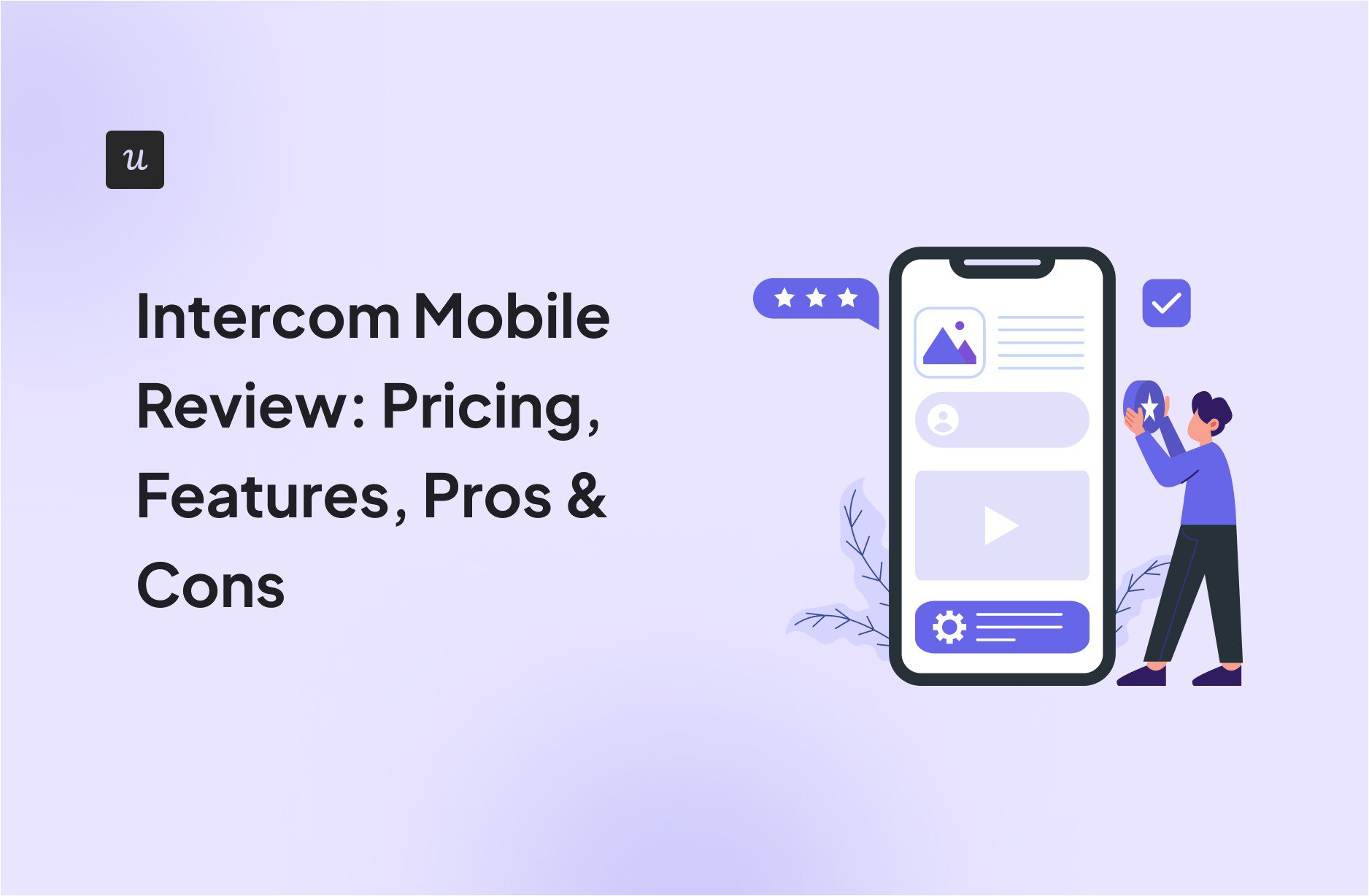
Intercom first launched in 2011 and has since rolled out regular updates, including the Mobile SDK to bring messaging and support directly into native apps. But is Intercom Mobile still worth the investment in 2025 and beyond?
This article will provide an in-depth review of the platform. We’ll cover its key features, pricing, and real user reviews. Then, show you where Intercom Mobile shines and when you might need alternatives.
Try Userpilot Now
See Why 1,000+ Teams Choose Userpilot

What is Intercom Mobile?
Intercom Mobile is a suite of mobile software development kits (SDKs) that lets you embed customer messaging, support, and engagement into your mobile app.
It currently supports apps built on iOS, Android, Cordova, and React Native.

Who is Intercom Mobile best for?
Based on its features and reviews from current users, Intercom Mobile is ideal for three primary customer groups:
- SMBs and mid-market SaaS companies: If you ship a native mobile app, you can install the SDK and launch in-app messaging instantly. No need to build a custom chat solution from scratch.
- Apps with high support volume or heavy engagement demands: When hundreds or thousands of mobile users are reaching out, Intercom Mobile automates routing, canned replies, and follow-ups so your team stays efficient under load.
- Existing Intercom customers: Already using Intercom’s web Messenger? Adding the Mobile SDK gives you one shared inbox for desktop and mobile. This allows customer service reps to maintain full context when users switch devices.
Core features at a glance: Intercom Mobile
So, how exactly does Intercom support mobile apps? Below are seven of its core features:
1. In-app messages: Intercom allows you to create contextual in-app messages that trigger based on user actions. You can deliver these messages as badges, snippets, or full-screen messages.

2. Push notifications: With Intercom, you can deep-link push notifications to specific screens, include images for richer engagement, and personalize content using any user attributes you track.

3. Mobile chat (Messenger SDK): The Messenger SDK brings the full Intercom Messenger into your native app. Users can jump straight into live chat, browse help center articles, or interact with bots for instant answers, all without leaving your app.

4. Mobile carousels and surveys: Mobile carousels are swipeable, multi-page messages you can design without code to guide users through key flows. This feature complements the survey feature well: after providing a contextual guide, you can trigger in-app surveys to gather user opinions and identify any pain points.
5. Custom bots and automations: Intercom lets you create bots and automated workflows that answer common user questions, qualify leads, and even route complex queries to the right human agent.

6. Audience segmentation and targeting: You can create user groups based on their attributes, behaviors, or custom data like subscription plan, app version, and in-app purchase status.
7. Basic analytics and reporting: Intercom Mobile includes a built-in dashboard for monitoring in-app message performance, open and click rates, and overall engagement trends without exporting data. However, these analytics are siloed to the mobile channel. You’ll need a third-party tool if you want cross-platform reports or deeper cohort analysis.

Intercom Mobile pricing
Intercom Mobile comes as an add-on to Intercom’s Web Messenger and Help Center packages. The add-on is priced at $99 per month for 500 messages (in-app messages, carousels, surveys, and push notifications all count as Messages).
What you actually pay skyrockets quickly, depending on your pricing plan and needs.
That said, here’s what the basic pricing looks like:
- Essential: $29 per seat/month
- Advanced: $85 per seat/month
- Expert: $132 per seat/month
If you’re on the Essential plan with only one seat and no extra features like multi-channel support and AI tools, your pricing will be $128/month ($29 for the base plan, plus $99 for Intercom Mobile).

What real users say: Intercom Mobile pros and cons
Now that you know the features and pricing, let’s see what actual users think of the tool.
Intercom Mobile pros
Easy-to-use in-app message builder
Intercom stands out for its ease of use. Customers can quickly build in-app experiences and deliver contextual support without requiring dev involvement.
“The combination of live chat, automation, and integrated help content makes Intercom a powerhouse for both support and conversion. The ability to use Snippets, macros, and auto-replies helps our Client Success team stay fast and consistent, while tools like Custom Bots and Workflows let us engage leads without needing a dev.”

(Note: G2 lists the product as “Fin by Intercom,” but many reviews, like the one above, also reflect experiences with the Mobile SDK and other Intercom offerings.)
Seamless handoff between web and mobile chats
Every conversation, whether on desktop or in your mobile app, flows into the same shared inbox.
“The product really has a good user experience for the end-user. Fantastic that you can have the same customer support on both website and in the app, which all are linked up together.”

Rapid setup with minimal dev effort
The installation process takes a few minutes, unless you’re adding custom tracking.
“Its easy to setup, quick learning curve, has good set of features and excellent integrations.”

Intercom Mobile cons
Poor customer support
For a support tool, it’s quite a surprise to see many users complain about the lack of sufficient customer support.
“Customer support is extremely poor – it often takes hours or even days to get a response, and you’re constantly passed between agents who lose track of the issue, forcing you to repeat yourself multiple times.”

Lack of in-depth analytics
Intercom Mobile does not include built-in funnel or cohort analysis, so you can’t easily map user journeys or measure long-term retention.
Some users also complain that the segmentation filters don’t let you combine multiple criteria, making it hard to pinpoint specific in-app behaviors.
“Given all the app insights Intercom gets from our product, it offers next to zero reporting or analytics.”

Another user added:
“Intercom maybe good for customer support but for product adoption, it’s not sophisticated enough”

That criticism is spot-on. A tool like Userpilot is a better fit if your goal is to access in-depth analytics and deliver adoption-driving flows.
Intercom Mobile vs. Userpilot Mobile
Let’s break down how each platform handles support, in-app guidance, and analytics, so you can see which one fits your goals.
| Feature | Intercom Mobile | Userpilot Mobile |
| Surveys | Basic surveys only (NPS and simple polls) | Advanced in-app surveys (NPS, CSAT, CES, etc) with flexible triggers and flows |
| Cross-Platform Analytics | Messaging-focused metrics only; no built-in cross-platform analytics | Native cross-platform analytics with funnel, cohort and retention reporting across web and mobile |
| Multi-App Funnel Tracking | Not available | Built-in multi-app funnel tracking and deep user journey analysis |
| Localization | Manual only. You author each language variant of messages, carousels and surveys by hand | AI-driven and manual localization options are available |
| Primary focus | Messaging and user communication | User engagement, onboarding, and re-engagement |
Why Userpilot Mobile is a great Intercom Mobile alternative
Userpilot Mobile steps in when you need more than just messaging. Its rich feature set and usage-based pricing empower product teams to experiment freely and optimize in-app experiences without unexpected costs.
Let’s explore why you might choose Userpilot Mobile over Intercom Mobile:
1. Agile, no-code implementation: Userpilot’s intuitive, drag-and-drop builder lets your product team create and update in-app experiences without touching a single line of code. You can A/B test different flows, tweak messaging or layout on the fly, and roll out changes to users in minutes.
2. Unified web and mobile experience: All your in-app guides and analytics live in a single dashboard and work across both web and mobile platforms. This consistency means users see the same onboarding and engagement flows regardless of device, and your data stays centralized for easy reporting.

3. Comprehensive in-app engagement tools: Userpilot’s mobile SDK includes carousels, slideouts, push notifications, and in-app surveys. These tools let you capture customer feedback at exactly the right moment and trigger personalized experiences that boost retention.

4. Advanced analytics and segmentation: Userpilot’s analytics panel provides built-in funnel analysis, cohort tracking, and event-level insights for both web and mobile. Its powerful segmentation engine lets you combine multiple attributes and custom events to create granular audiences for targeted campaigns.

5. Multilingual support and powerful localization features: Unlike Intercom Mobile, Userpilot offers AI-powered, one-click translation into over 32 languages. You can also import CSV or XLIFF files for manual edits and fine-tuning.

Don’t take our word for it. Here’s what Tom Ulman has to say after 3P learning used Userpilot to improve adoption:

Final verdict: Should you choose Intercom Mobile?
Intercom Mobile is hard to beat if your primary goal is to chat directly with customers and send quick in-app messages at scale.
However, Userpilot Mobile is the stronger choice if you’re more focused on adoption, deep in-app guidance, and advanced behavior analytics.
Ready to give Userpilot a try? Book a demo call with our team and see how Userpilot can help you build no-code flows, translate content automatically into multiple languages, and measure funnels and cohorts across web and mobile.
FAQ
Can I use Intercom for free?
Intercom doesn’t offer a forever-free plan, only a 14-day free trial. After that, you’ll need to choose a paid tier based on your active user volume and feature needs.
Is Intercom easy to use?
Yes. Intercom’s drag-and-drop message builder and prebuilt mobile SDK make setup straightforward, even without developer support. That said, mastering advanced segmentation and automations can take a bit of time.
How old is Intercom?
Intercom was founded in 2011, so as of 2025, it’s about 14 years old.







